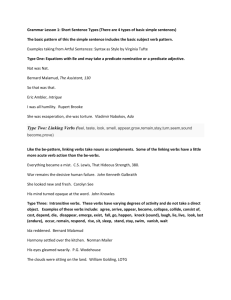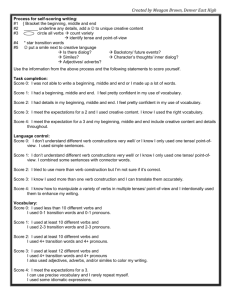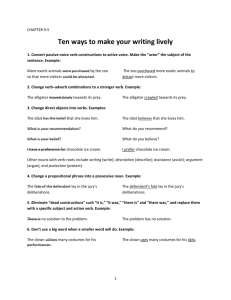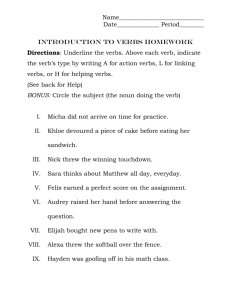docx - University of Liverpool
advertisement
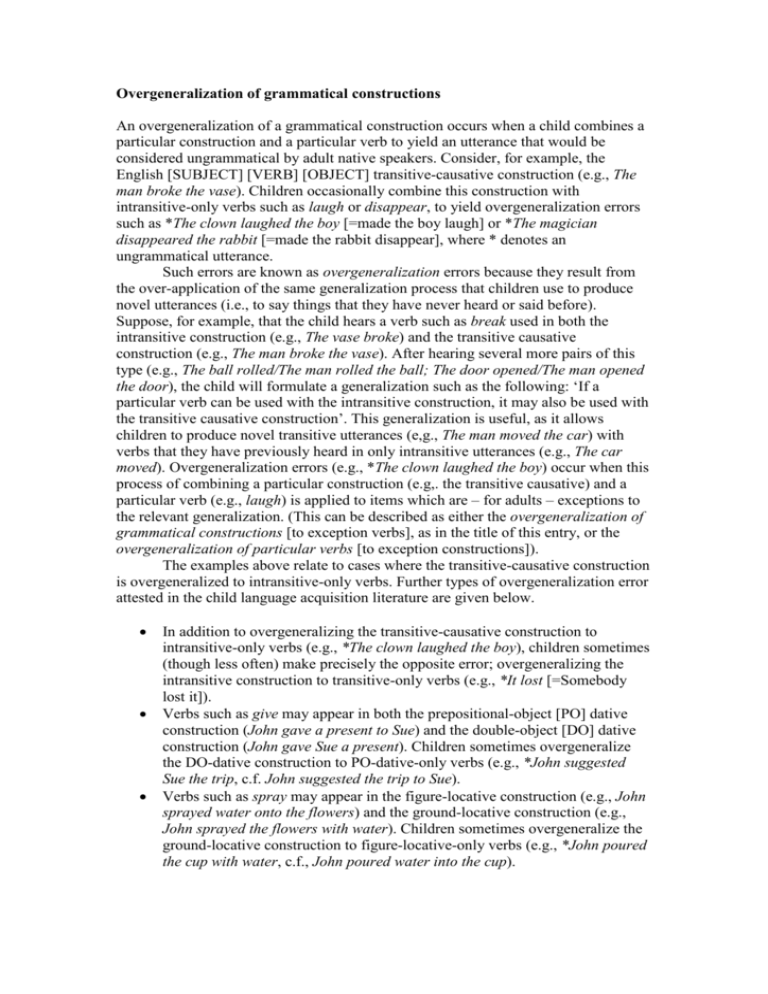
Overgeneralization of grammatical constructions An overgeneralization of a grammatical construction occurs when a child combines a particular construction and a particular verb to yield an utterance that would be considered ungrammatical by adult native speakers. Consider, for example, the English [SUBJECT] [VERB] [OBJECT] transitive-causative construction (e.g., The man broke the vase). Children occasionally combine this construction with intransitive-only verbs such as laugh or disappear, to yield overgeneralization errors such as *The clown laughed the boy [=made the boy laugh] or *The magician disappeared the rabbit [=made the rabbit disappear], where * denotes an ungrammatical utterance. Such errors are known as overgeneralization errors because they result from the over-application of the same generalization process that children use to produce novel utterances (i.e., to say things that they have never heard or said before). Suppose, for example, that the child hears a verb such as break used in both the intransitive construction (e.g., The vase broke) and the transitive causative construction (e.g., The man broke the vase). After hearing several more pairs of this type (e.g., The ball rolled/The man rolled the ball; The door opened/The man opened the door), the child will formulate a generalization such as the following: ‘If a particular verb can be used with the intransitive construction, it may also be used with the transitive causative construction’. This generalization is useful, as it allows children to produce novel transitive utterances (e,g., The man moved the car) with verbs that they have previously heard in only intransitive utterances (e.g., The car moved). Overgeneralization errors (e.g., *The clown laughed the boy) occur when this process of combining a particular construction (e.g,. the transitive causative) and a particular verb (e.g., laugh) is applied to items which are – for adults – exceptions to the relevant generalization. (This can be described as either the overgeneralization of grammatical constructions [to exception verbs], as in the title of this entry, or the overgeneralization of particular verbs [to exception constructions]). The examples above relate to cases where the transitive-causative construction is overgeneralized to intransitive-only verbs. Further types of overgeneralization error attested in the child language acquisition literature are given below. In addition to overgeneralizing the transitive-causative construction to intransitive-only verbs (e.g., *The clown laughed the boy), children sometimes (though less often) make precisely the opposite error; overgeneralizing the intransitive construction to transitive-only verbs (e.g., *It lost [=Somebody lost it]). Verbs such as give may appear in both the prepositional-object [PO] dative construction (John gave a present to Sue) and the double-object [DO] dative construction (John gave Sue a present). Children sometimes overgeneralize the DO-dative construction to PO-dative-only verbs (e.g., *John suggested Sue the trip, c.f. John suggested the trip to Sue). Verbs such as spray may appear in the figure-locative construction (e.g., John sprayed water onto the flowers) and the ground-locative construction (e.g., John sprayed the flowers with water). Children sometimes overgeneralize the ground-locative construction to figure-locative-only verbs (e.g., *John poured the cup with water, c.f., John poured water into the cup). Conversely, children sometimes overgeneralize the figure-locative construction to ground-locative-only verbs (e.g., *John filled water into the cup, c.f., John filled the cup with water). Morphological overgeneralization errors (e.g., *throwed, *unsqueeze) are sometimes analyzed as involving the overgeneralization of grammatical constructions at the level of individual words (VERB+ed; un+VERB). Although little research has addressed this question directly, overgeneralization errors presumably reflect children’s failure to have learned (a) the adult restrictions on particular construction+verb combinations (e.g., that laugh may not appear in the transitive-causative construction) and/or (b) an alternative construction that expresses the child’s desired meaning. For example, in place of an overgeneralization error such as *The clown laughed the boy, an adult would probably use the periphrastic causative ‘make’ construction (e.g., The clown made the boy laugh). A child who has not yet learned this construction may use the most suitable construction in her repertoire, even if this yields an utterance that she considers less than fully acceptable. Most research has focused on the processes by which children retreat from (or avoid) overgeneralization errors. There is empirical support, from both production and grammaticality-judgment studies, for three mechanisms. Entrenchment is a process by which each attested use of a particular verb (e.g., The boy laughed; Stop laughing at me!; The clown made the boy laugh) contributes to an ever-strengthening probabilistic inference that non-attested uses are not permitted. The inference is that if one has encountered, for example, laugh, hundreds or thousands of times, yet never in the transitive-causative construction, then it is extremely unlikely that this nonoccurrence is a mere co-incidence; most likely, it reflects a genuine ‘gap’ in the system. Pre-emption is similar to entrenchment except that non-attested uses (e.g., *The clown laughed the boy) are blocked not by any occurrence of the relevant verb, but only by uses in nearly-synonymous constructions (e.g., The clown made the boy laugh). The assumption is that children are learning the preferred form for expressing each particular meaning. Finally, children become increasingly sensitive to any mismatch between the fine-grained meanings of individual verbs and individual constructions. For example, under this account, the reason that *The clown laughed the boy is ungrammatical is that laugh denotes a semi-voluntary, internally-caused, single-participant event, whilst the transitive-causative construction prototypically denotes a deliberate, externally-caused, two-participant event (e.g., The man cleaned the clothes). Under the best-known version of this account, children create semantic classes of verbs with similar meanings that share similar constructional restrictions (e.g., The boy laughed/giggled/chuckled *The clown laughed/giggled/chuckled the boy; The ball bounced/rolled/slid The man bounced/rolled/slid the ball). Ben Ambridge University of Liverpool See Also: Argument structure (acquisition of); Generalization of linguistic patterns; Grammaticality judgment task; Overregularization in morphological development; Statistical pre-emption. Further Readings Ambridge, Ben, Pine, Julian M., Rowland, Caroline F., Chang, Franklin and Bidgood, Amy. “The retreat from overgeneralization in child language acquisition: Word learning, morphology and verb argument structure.” Wiley Interdisciplinary Reviews: Cognitive Science, v.4 (2013). Ambridge, Ben and Lieven, Elena V.M. Child language acquisition: Contrasting theoretical approaches. Cambridge: Cambridge University Press, 2011. (see p.242265).



